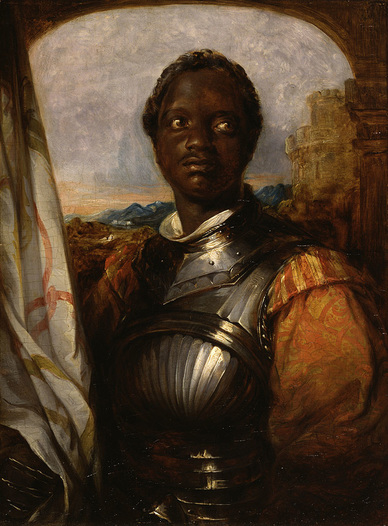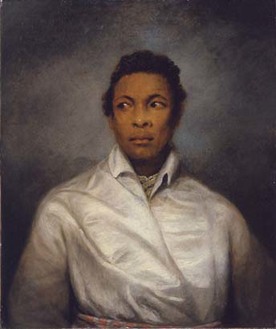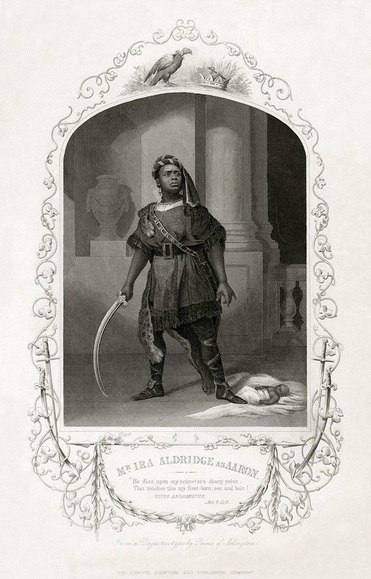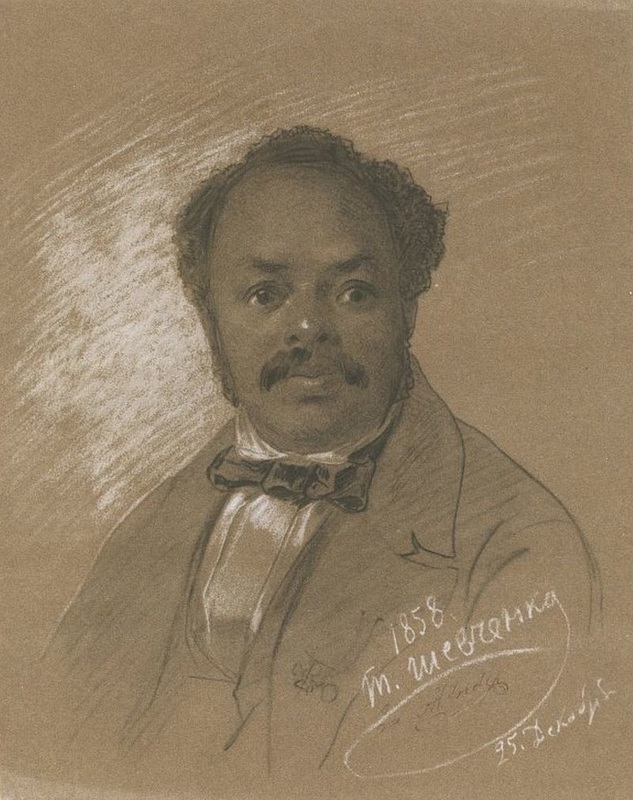Ira Aldridge: The African Roscius (1807-1867)
Ira Frederick Aldridge was an African American stage actor who featured in plays on both sides of the Atlantic. During his tours of Britain, Aldridge visited the East Riding of Yorkshire periodically between 1829 and 1859 playing a wide variety of characters. He was reportedly the only famous Black actor who featured on the stage in Britain in the mid-nineteenth century. In 1851 John Tallis wrote that Aldridge was ‘believed to be the only member of his race who ever adopted the stage as a profession.’[1]
Aldridge's Background
Aldridge was born on 24 July 1807. His father was Reverend Daniel Aldridge, the son of a Fulah chief who fled to America after his family were butchered by their own tribe, and his mother was Luranah Aldridge. Although slavery was commonplace in certain parts of America, particularly in the South, Aldridge’s family were free and resided in New York where a law for the gradual abolition of slavery had been passed in 1799.
At the age of thirteen Aldridge attended the African Free School in New York which was established to give free and enslaved Black children an education. Although Aldridge’s father wanted him to follow in his footsteps and become a man of the church, the aspiring actor had very different ideas. After his first visit to the theatre Aldridge fell in love with the stage and began to spend his evenings behind the scenes in the Chatham Theatre, New York. Unfortunately, his time there came to an abrupt end when he was sent to Schenectady College to prepare for a life in the ministry.
After a short time at the college, Aldridge was sent abroad to Glasgow University to further his education. His mentor was Professor Sandford and under his guidance Aldridge received several premiums and a medal for Latin composition.[2] Although Aldridge excelled academically, after eighteen months he left the university to pursue his true passion, the stage. In order to follow his dreams, Aldridge moved to London where he eventually secured the role of Othello at the small Royalty Theatre in Soho. He then moved on to the Royal Cobourg Theatre where he performed Oroonoko for the first time. As a result of his success the young African American actor obtained several leading roles at the Sadler Wells theatre before taking to the stage at the more prestigious Olympic theatre.
Aldridge’s reputation grew rapidly, but in order to reach the fame he desired, he began a provincial tour of Britain. He visited Brighton, Chichester, Leicester, Liverpool, Manchester, Hull, Glasgow, Edinburgh, Exeter and many other cities around the UK.
Aldridge was born on 24 July 1807. His father was Reverend Daniel Aldridge, the son of a Fulah chief who fled to America after his family were butchered by their own tribe, and his mother was Luranah Aldridge. Although slavery was commonplace in certain parts of America, particularly in the South, Aldridge’s family were free and resided in New York where a law for the gradual abolition of slavery had been passed in 1799.
At the age of thirteen Aldridge attended the African Free School in New York which was established to give free and enslaved Black children an education. Although Aldridge’s father wanted him to follow in his footsteps and become a man of the church, the aspiring actor had very different ideas. After his first visit to the theatre Aldridge fell in love with the stage and began to spend his evenings behind the scenes in the Chatham Theatre, New York. Unfortunately, his time there came to an abrupt end when he was sent to Schenectady College to prepare for a life in the ministry.
After a short time at the college, Aldridge was sent abroad to Glasgow University to further his education. His mentor was Professor Sandford and under his guidance Aldridge received several premiums and a medal for Latin composition.[2] Although Aldridge excelled academically, after eighteen months he left the university to pursue his true passion, the stage. In order to follow his dreams, Aldridge moved to London where he eventually secured the role of Othello at the small Royalty Theatre in Soho. He then moved on to the Royal Cobourg Theatre where he performed Oroonoko for the first time. As a result of his success the young African American actor obtained several leading roles at the Sadler Wells theatre before taking to the stage at the more prestigious Olympic theatre.
Aldridge’s reputation grew rapidly, but in order to reach the fame he desired, he began a provincial tour of Britain. He visited Brighton, Chichester, Leicester, Liverpool, Manchester, Hull, Glasgow, Edinburgh, Exeter and many other cities around the UK.
|
Aldridge Performs at the Theatre Royal, Humber Street, Hull: 1829
Aldridge’s first performance in Hull was at the Theatre Royal on Humber Street where he played ‘Othello, the Moor of Venice,’ on 8 June 1829. A surviving playbill held at the British Library, London advertises Aldridge as ‘one of the greatest Novelties in the Theatrical World- AN ACTOR OF COLOUR.’ It goes on to detail that ‘his extraordinary abilities have been witnessed with the most general applause and universal satisfaction.’[3] After his successful portrayal of the Shakespearian character an observer wrote in the Hull Packet: "We attended the theatre impressed with an idea that the playing the part of Othello, by a native African- or at least by one born of African parents, and bearing an African complexion of the purest and deepest tint- would turn out to be what is sometimes called in theatrical parlance “a gag.” We were agreeably disappointed…[Aldridge] through positively a negro, is a gentleman and a man of education, and could not have portrayed the character in a style much more intellectual, if his face had been “as white as unsunned snow.” The house was unfortunately not so well attended as we could have wished, but there was not an individual present who did not honour his performance- long, and even tedious, as the tragedy is in parts- with almost breathless attention. The applause was on several occasions given in reiterated peals.’"[4] Over the course of the second and third nights, Aldridge assumed the roles of Oroonoko, Zanga in The Revenge and Mungo in The Padlock.[5] However, they were not as well received as his performance of Othello. A writer for the Hull Packet advised: "His Oroonoko we did not see; his Zanga, in our estimation, was a very inferior attempt to his Othello. We still had to complain of the extremely slow and elaborate manner in which he gave the mere dialogue of the part, and by which the play was rendered insufferably heavy and tedious… In the afterpiece he played Mungo remarkably well. He was natural and easy, and displayed a considerable share of humour… The “Roscius” sang his part like a hero, and even did his best to help out his colleague but the attempt was vain."[6] |
Aldridge at the Royal Adelphi Theatre, Hull: 1831
Aldridge returned to Hull three years later in 1831 to perform at the Royal Adelphi Theatre which was located on the corner of Wellington and Queen Street. He took to the stage for four consecutive nights from 31 August. On his first night he took the part of Mungo in ‘the popular Musical Farce The Padlock.[7] During the subsequent evenings audiences witnessed a performance of Liberty and Slavery, with Aldridge assuming the role of Gambia and a new character Karfa in Three Fingered Jack.
He may have returned to Hull in the subsequent year to bring the role of Karfa back to the stage for the first time after the Great Jamaican Revolt, an event which occurred in late 1831 and early 1832.[8] The rebellion lasted for eleven days and involved around 60,000 people, approximately one fifth of Jamaica’s slave population. It was initiated by Black preacher Samuel Sharpe who fought for more freedom and a working wage. However, when planters would not agree with these terms a full scale rebellion broke out. The role of three fingered Jack, which was based on a real character who escaped from slavery and was eventually captured and killed may have been seen as controversial after the uprising. However, Aldridge embraced the themes of enslavement and the struggle for freedom in Hull in the early 1830s at a time when William Wilberforce was campaigning to abolish slavery in the British colonies. Whether Aldridge was more comfortable playing roles which tackled contemporary issues in Hull because of Wilberforce’s influences on the city remains unknown. However, it is likely that his audience were sympathetic to a young Black actor and his portrayal of the plight of slaves across the Atlantic.
Aldridge returned to Hull three years later in 1831 to perform at the Royal Adelphi Theatre which was located on the corner of Wellington and Queen Street. He took to the stage for four consecutive nights from 31 August. On his first night he took the part of Mungo in ‘the popular Musical Farce The Padlock.[7] During the subsequent evenings audiences witnessed a performance of Liberty and Slavery, with Aldridge assuming the role of Gambia and a new character Karfa in Three Fingered Jack.
He may have returned to Hull in the subsequent year to bring the role of Karfa back to the stage for the first time after the Great Jamaican Revolt, an event which occurred in late 1831 and early 1832.[8] The rebellion lasted for eleven days and involved around 60,000 people, approximately one fifth of Jamaica’s slave population. It was initiated by Black preacher Samuel Sharpe who fought for more freedom and a working wage. However, when planters would not agree with these terms a full scale rebellion broke out. The role of three fingered Jack, which was based on a real character who escaped from slavery and was eventually captured and killed may have been seen as controversial after the uprising. However, Aldridge embraced the themes of enslavement and the struggle for freedom in Hull in the early 1830s at a time when William Wilberforce was campaigning to abolish slavery in the British colonies. Whether Aldridge was more comfortable playing roles which tackled contemporary issues in Hull because of Wilberforce’s influences on the city remains unknown. However, it is likely that his audience were sympathetic to a young Black actor and his portrayal of the plight of slaves across the Atlantic.
Aldridge at the Nag’s Head in Driffield: 1841
Aldridge arrived at the Assembly Rooms attached to the Nag’s Head in Driffield in July 1841. His performances were well received by large crowds who visited the venue. An article in the Hull Advertiser and Exchange Gazette read:
"Whether in deep tragedy or ludicrous comedy he is equally clever. In negro parts he is the very beau ideal of a “Mungo,” or a “Ginger Blue,” and the less amiable and grotesque traits of low cunning and deceit, and the love of money and strong drink, inherent in the negro tribe, are portrayed to the very life. In the course of the entertainments, the African Roscius appeared as “Othello,” “Shylock” in the Merchant of Venice, “Zenga” in the Revenge, “Mungo” in the Padlock, “Ginger Blue” in the Virginian Mummy, and other popular pieces, assisted by other members of the sock and buskin. The entertainments were enlivened and diversified by music and singing. The comic songs of “Sich a getting up stairs,” and “Jim Crow” by the African Roscius, with many whimsical allusions to the localities and comicalities of the town of Driffield, were highly applauded."[9]
Aldridge arrived at the Assembly Rooms attached to the Nag’s Head in Driffield in July 1841. His performances were well received by large crowds who visited the venue. An article in the Hull Advertiser and Exchange Gazette read:
"Whether in deep tragedy or ludicrous comedy he is equally clever. In negro parts he is the very beau ideal of a “Mungo,” or a “Ginger Blue,” and the less amiable and grotesque traits of low cunning and deceit, and the love of money and strong drink, inherent in the negro tribe, are portrayed to the very life. In the course of the entertainments, the African Roscius appeared as “Othello,” “Shylock” in the Merchant of Venice, “Zenga” in the Revenge, “Mungo” in the Padlock, “Ginger Blue” in the Virginian Mummy, and other popular pieces, assisted by other members of the sock and buskin. The entertainments were enlivened and diversified by music and singing. The comic songs of “Sich a getting up stairs,” and “Jim Crow” by the African Roscius, with many whimsical allusions to the localities and comicalities of the town of Driffield, were highly applauded."[9]
|
The Queens Theatre, Paragon Street, Hull: 1849 & 1856
Aldridge returned to Hull in July 1849 where he agreed to play for six nights consecutively at the Queens Theatre located on Paragon Street. Its central location near the new railway station meant that theatre attendees from across the region could access the cultural productions more easily. It was the largest theatre in the city and therefore was able to accommodate extremely large crowds.[10] A writer at the Hull Advertiser and Exchange Gazette advised readers: "We have had this week the opportunity of witnessing the eminent and tragic powers of Mr Ira Aldridge, the African Roscious. We attended his performance of “Othello”, and we have rarely witnessed a more admirable and striking impersonation of that wonderful creation of our great Bard. His conception of the Moor was just. He did not protract the violence of passionate excitement, or allow it to throw into the shadows every other emotion and feeling that is made to the poet to take possession of Othello’s breast, but gave his personalisation of the character a due effect to all the varied phrases of his agitated nature, and portrayed their transitions with a power evidently guided by judgement and correct sense."[11] Aldridge was welcomed back to the Queen’s Theatre in March 1856 playing for six consequetive nights beginning on 10 March. However, securing a performance by the prestigious African actor was not cheap. On 7 March 1856, the Hull Packet suggested that: "Messrs. Wolfenden & Melbourne have much pleasure in announcing to their patrons that they have, at an enormous expense, secured the services of the celebrated African Roscious, after an absence… from England."[12] |
On this visit to the city a number of Aldridge’s roles focused upon slavery, which was yet to be abolished in the Americas. The audiences who visited the Royal Queen’s Theatre saw Aldridge as Aaron the Moor (pictured above) in his adaptation of the exceptionally violent and bloody Shakespearian tragedy Titus Andronicus. Although the play had been rather popular, unlike other plays by Shakespeare that were experiencing a resurgence in popularity in the Victorian era, Andronicus had been abandoned by theatre producers because of its barbaric nature. However, Aldridge adapted the play for a contemporary audience and it is likely that the play was very well received.
|
The performance was followed by songs performed by Aldridge, one of which was entitled, ‘Opossum up a gum tree.’ This was a popular song among slaves in the Americas.
|
To conclude, Aldridge played a role in Paul and Virginia. This play was based upon a novel written by Jacques-Henri Bernardin de Saint-Pierre and was published in 1788. The story was set on French owned Mauritius and centres on the two title characters who fall in love. Aldridge may have selected this play because it was about challenging the divisions found in society and highlighted that all slaves should be emancipated.
During his time at the Queen’s Theatre Aldridge performed The Slave’s Revenge, a play written by William Barrymore. The play tells the story of a slave, Cato, and his sister Ora. Cato’s turbulent time as a slave prompts him to plan the murder of his master. However, the plan fails and he is executed and dies in Ora’s arms. Aldridge also played the star role in The Black Doctor which he adapted for the stage. The story centres upon Fabian, a mixed race physician who marries a white French woman. It explores racial tensions and family conflicts. It is likely that the play was close to Aldridge’s heart as he married an English and then Swedish woman both of whom were Caucasian.
During his time at the Queen’s Theatre Aldridge performed The Slave’s Revenge, a play written by William Barrymore. The play tells the story of a slave, Cato, and his sister Ora. Cato’s turbulent time as a slave prompts him to plan the murder of his master. However, the plan fails and he is executed and dies in Ora’s arms. Aldridge also played the star role in The Black Doctor which he adapted for the stage. The story centres upon Fabian, a mixed race physician who marries a white French woman. It explores racial tensions and family conflicts. It is likely that the play was close to Aldridge’s heart as he married an English and then Swedish woman both of whom were Caucasian.
A Final Visit to Hull
Aldridge returned to Hull in 1859 after his tour of Europe. The Hull Advertiser and Exchange Gazette advised readers that Aldridge would be accompanied by the African Opera Troupe and the most complete band of minstrels ever organised.[14] This would be the last time Aldridge visited the city before he died at Lodz in Poland on 7 August 1867.
Aldridge was a pioneer of his time not only because he was the first famous Black actor to tour Britain but because he was not afraid to confront contemporary issues of slavery and freedom within his performances. Unfortunately, we do not know if Aldridge and William Wilberforce met during his time in Hull, however they were unified in their distaste for slavery.
Aldridge returned to Hull in 1859 after his tour of Europe. The Hull Advertiser and Exchange Gazette advised readers that Aldridge would be accompanied by the African Opera Troupe and the most complete band of minstrels ever organised.[14] This would be the last time Aldridge visited the city before he died at Lodz in Poland on 7 August 1867.
Aldridge was a pioneer of his time not only because he was the first famous Black actor to tour Britain but because he was not afraid to confront contemporary issues of slavery and freedom within his performances. Unfortunately, we do not know if Aldridge and William Wilberforce met during his time in Hull, however they were unified in their distaste for slavery.
Footnotes
[1] John Tallis, Tallis drawing room table book of theatrical portraits, memoirs and anecdotes (London: J. Tallis, 1851), p. 15.
[2] Ibid, p. 15.
[3] BBC website, http://www.bbc.co.uk/programmes/articles/1bhlZVzdSWhJ5NJzC8MnmC0/the-first-black-shakespearean-actor-performs-in-hull-the-bastion-of-the-anti-slavery-movement, accessed 30/09/2016.
[4] Hull Packet, 9 June 1829, p. 3.
[5] Hull Packet, 9 June 1829, p. 1.
[6] Hull Packet, 16 June 1829, p. 3.
[7] Hull Packet, 30 August 1831, p. 1.
[8] Bernth Lindfors, Ira Aldridge: The Early Years 1807-1833 (New York: University of Rochester Press, 2011), p. 179
[9] Hull Advertiser and Exchange Gazette, 30 July 1841, p. 6.
[10] Hull Advertiser and Exchange Gazette, 13 July 1849, p. 2.
[11] Hull Advertiser and Exchange Gazette, 6 July 1849, p. 4.
[12] Hull Packet, 7 March 1856, p. 4.
[13] Katrina Dyonne Thompson, Ring Shout, Wheel About: The Radical Politics of Music and Dance in North American Slavery (Illinois: University of Illinois, 2014) p. 62-63.
[14] Hull Advertiser and Exchange Gazette, 4 June 1859, p.4.
[1] John Tallis, Tallis drawing room table book of theatrical portraits, memoirs and anecdotes (London: J. Tallis, 1851), p. 15.
[2] Ibid, p. 15.
[3] BBC website, http://www.bbc.co.uk/programmes/articles/1bhlZVzdSWhJ5NJzC8MnmC0/the-first-black-shakespearean-actor-performs-in-hull-the-bastion-of-the-anti-slavery-movement, accessed 30/09/2016.
[4] Hull Packet, 9 June 1829, p. 3.
[5] Hull Packet, 9 June 1829, p. 1.
[6] Hull Packet, 16 June 1829, p. 3.
[7] Hull Packet, 30 August 1831, p. 1.
[8] Bernth Lindfors, Ira Aldridge: The Early Years 1807-1833 (New York: University of Rochester Press, 2011), p. 179
[9] Hull Advertiser and Exchange Gazette, 30 July 1841, p. 6.
[10] Hull Advertiser and Exchange Gazette, 13 July 1849, p. 2.
[11] Hull Advertiser and Exchange Gazette, 6 July 1849, p. 4.
[12] Hull Packet, 7 March 1856, p. 4.
[13] Katrina Dyonne Thompson, Ring Shout, Wheel About: The Radical Politics of Music and Dance in North American Slavery (Illinois: University of Illinois, 2014) p. 62-63.
[14] Hull Advertiser and Exchange Gazette, 4 June 1859, p.4.
Links to Ira Aldridge in Hull
|
Othello in Hull – celebrating #Shakespeare400: Ira Aldridge in Hull
by Chris Marr Ira Aldridge in Hull on the BBC Shakespeare on Tour website
|



